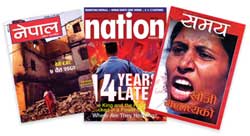 Bad news seems to be good news: in the past week there has been a flashflood of slick new weekly magazines hitting the stands.
Bad news seems to be good news: in the past week there has been a flashflood of slick new weekly magazines hitting the stands.
Kantipur Publication's Nepal pre-empted the launch of its former group editor Yubaraj Ghimire's Samaya by going weekly last month. Samaya itself came out this week. In English, the news stands have seen the advent of yet another weekly magazine, Nation.
All three new contenders are aiming at the mainstream middle class market in English and Nepali, hoping that better printing quality and upgraded news content will draw advertisers. Media analysts see Nepal and Samaya jostling for the same readership, while Nation takes on 12-year-old English Spotlight.  The weekly market is now going to be crowded as established political tabloids like Drishti and Bimarsha have spruced up and gone through major layout revamps. Registration records at the Information Department show that 1,300 of the 3,700 licensed publications in the country are weeklies. Not all of them are publishing, and the circulation battle is going to be between the two new entrants and the tabloids.
The weekly market is now going to be crowded as established political tabloids like Drishti and Bimarsha have spruced up and gone through major layout revamps. Registration records at the Information Department show that 1,300 of the 3,700 licensed publications in the country are weeklies. Not all of them are publishing, and the circulation battle is going to be between the two new entrants and the tabloids.
At a time when there are so many dailies, is there really a need for weekly newsmagazines in Nepali? Yubaraj Ghimire, who edited The Kathmandu Post and Kantipur before starting Samaya says there were aberrations in the dailies that ignored corruption and diverted attention from real issues. "This is the space that weeklies can fill and demonstrate professionalism, accountability and credibility," he told us.
With so much going on, it seems the weeklies have their work cut out to deliver what they promise. "This is where we fit in," explains Nepal's editor Sudhir Sharma. "Our niche will be news reports, features, analyses and investigative pieces."
Ghimire reckons the reading population is getting more sophisticated and expects greater professionalism and quality from magazines. "Our professional ability and capability will be tested," he adds. Sharma thinks the shift from fortnightly to weekly will be seamless. "We are already very well established and have a headstart," he says.  Samaya is brought out by Bhrikuti Publications which has travel entrepreneur Bharat Basnet as its chairman, while Nation is published by Mirror Media.
Samaya is brought out by Bhrikuti Publications which has travel entrepreneur Bharat Basnet as its chairman, while Nation is published by Mirror Media.
Until recently, Himal Khabarpatrika, which is published by Himalmedia (also the publishers of Nepali Times), and Nepal were the two mainstream fortnightlies. Himalmedia has decided to keep its Himal Khabarpatrika a fortnightly. General Manager Anil Shrestha explains: "We had a serious business plan for a weekly two years ago, but concluded that it wasn't the right time to increase frequency with a sluggish economy and transportation problems."
The new English language weekly will face the same problem of a crowded market as the Nepali ones, but even more acutely because of the limited readership in English. The Nation's editor Akhilesh Upadhyay, however, is not
too concerned: "Good journalism is good business, and it is here to stay."  One question that nags those in the media industry is how sustainable the new publications will be since the advertising pie is not growing. "Even if the rise in the frequency and number is good news for readers," says media analyst P Kharel, "it is intriguing that even when it looks certain they will lose money, more publications are joining the fray."
One question that nags those in the media industry is how sustainable the new publications will be since the advertising pie is not growing. "Even if the rise in the frequency and number is good news for readers," says media analyst P Kharel, "it is intriguing that even when it looks certain they will lose money, more publications are joining the fray."
The conflict and political instability has brought the economy to its knees, and everyone, including the advertising industry, is hunkering down for the long haul. Joydeb Chakravarty of Thompson Nepal doesn't see how all the new publications can survive. "There will be a shakeout sooner or later because advertising budgets are not increasing at all," he says.
Till then at least, Nepali readers can enjoy greater choice, better quality journalism and the hope that increased competition will bring down prices like it has with the dailies.


